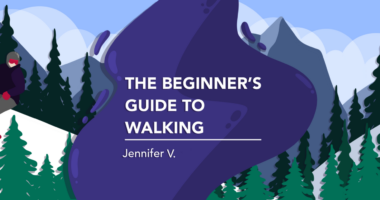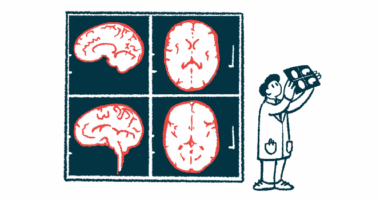Make It Count: A Visit With Prominent NMO Advocate Sumaira Ahmed

I have never met Sumaira Ahmed in person, but her energy and passion radiate through computer screens and phone calls. It’s what convinced many of us to follow her charge and become ambassadors for her nonprofit organization, The Sumaira Foundation for NMO, or TSF for short.
As TSF’s founder, Sumaira, 32, a New Jersey-born dancer, actress, and public relations manager, is unique among neuromyelitis optica (NMO) patients. After her diagnosis in 2014, she decided to take action, quickly becoming a leading advocate for NMO patients.
Sumaira and I met during a video call one recent chilly afternoon. Huddled in her chair, she was proudly dressed in a chic TSF sweater. Before leading an international foundation, Sumaira had trained to be a Bollywood dancer and actress. She’s a natural beauty, though I’m not sure she realizes how stunning she is, both inside and out. What makes her truly special, though, is her ability to make others feel just as beautiful as she is. Her welcoming smile always draws me in.
But don’t let Sumaira’s petite size fool you — her personality is as big as her heart and her courage.
Excerpts of our conversation follow.

Sumaira Ahmed, founder of The Sumaira Foundation for NMO. (Courtesy of The Sumaira Foundation for NMO)
JVA: Tell me about your NMO journey.
SA: It was two weeks shy of my 25th birthday when I lost vision in my right eye. I worked in ophthalmology, so I had access to doctors and testing. My colleagues noticed significant visual field deficit, but everything else was structurally fine.
They ordered an MRI, so the day before the Fourth of July, I went to the ER. I was naïve because I had my weekend bag with me thinking I was going to be in and out. The specialists told me I had inflammation in my brain.
I was in denial, because as a 24-year-old, you think you’re invincible. I didn’t tell anyone, not even my family. I was admitted and told there was a 16% chance of developing [multiple sclerosis] or a vitamin D deficiency, so my vision should come back.
I moved on with my life. Two weeks later, my body felt like it was burning. As a professional dancer, to have the vehicles to dance be somewhat in jeopardy was terrifying to me. I was admitted again, and this time they mentioned NMO for the first time.
Correct me if I’m wrong, but I believe you started The Sumaira Foundation from your hospital bed, right?
Something like that. When I left the hospital, I was devastated, terrified, and confused. On the ride home, I told my friend that I don’t know how yet, but somehow this will turn into a good thing. I believe things happen for a reason, that the universe is doing something here and it’s not obvious yet.
I was on bed rest for two weeks and looking online like everyone else does. What I needed to find as a newly diagnosed young patient with NMO did not exist. I didn’t want others to feel the way I did, so in September 2014, I announced the launch of TSF through Boston Magazine. It hadn’t even been a month since my diagnosis. We were incorporated in October, so two months after I came out of the hospital.
I had this fight-or-flight moment. If I’m going to die, I need to make this count. I need to help people while I can, and I need to raise awareness.
You refer to TSF as ‘we.’ Who are you referring to in those early days?
While the foundation bears my name, it’s not a one-woman show. I’ve always been fortunate to have the support of our board, patients, caregivers, doctors, advocates, and industry partners. I look at TSF as the people’s organization. We’re a patient-powered and patient-led organization.
After your NMO diagnosis, what was the most difficult aspect for you to accept?
I felt like I was in this nebulous place. No one knows why this happened, there’s no cure, at the time there was no therapy, and it’s not hereditary or genetic. So, did I do something that caused it?
How has NMO changed your outlook on your future?
I don’t plan for my future anymore. Tomorrow is not promised, and even if I’m here, it’s not promised that I’ll be feeling well or high-functioning. I tackle what’s in front of me and enjoy it.
How does advocacy work affect the quality of life of patients?
Firstly, advocacy reintroduces purpose and meaning that a lot of us felt like we lost when we got sick. It’s a great way to make your experience count. Secondly, any opportunity to elevate the patient voice, to inform positive change, is improving quality of life.
How does it affect legislation?
The more stories that are shared, not just about NMO, but rare disease in general, [the more it] helps decision-makers and policy change-makers understand the patient journey.
Big pharma?
They can’t just hear one or two stories and decide for an entire community. Instead, advocacy exposes them to a variety of experiences, and it impacts research and treatments.
You?
I don’t know who I would be today without advocacy, and over the last eight years, it has become my life. It has been the most enriching experience and the biggest honor of my life.
Note: Neuromyelitis News is strictly a news and information website about the disease. It does not provide medical advice, diagnosis, or treatment. This content is not intended to be a substitute for professional medical advice, diagnosis, or treatment. Always seek the advice of your physician or other qualified health providers with any questions you may have regarding a medical condition. Never disregard professional medical advice or delay in seeking it because of something you have read on this website. The opinions expressed in this column are not those of Neuromyelitis News or its parent company, Bionews, and are intended to spark discussion about issues pertaining to neuromyelitis optica spectrum disorder (NMOSD).







Leave a comment
Fill in the required fields to post. Your email address will not be published.